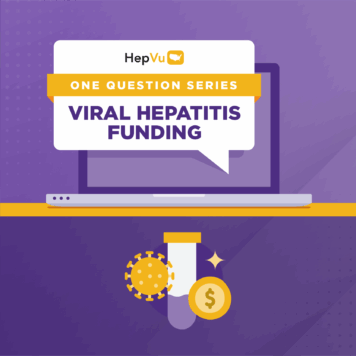Selected and summarized by Ronald O. Valdiserri, MD, MPH, Professor, Department of Epidemiology, Rollins School of Public Health, Emory University, and Co-Chair of HepVu.
Dr. Valdiserri reviews significant articles on prevention, public health, and policy advances in viral hepatitis. This month, he highlights “Modelling the potential impact of global hepatitis B vaccination on the burden of chronic hepatitis B in the United States.” Hutton DW, Toy M, Yang D, Zhang H, Handanagic S, et al. Journal of Viral Hepatology, 2024 October; 31(10): 614-622. doi: 10.1111/jvh.13982
What question(s) does this study address?
In 2020, a panel of expert hepatologists estimated that between 1.25 and 2.49 million persons in the United States were living with chronic Hepatitis B virus (HBV) infection. Their analysis noted that foreign-born persons living in the US consistently have a higher prevalence of HBV infection compared to US-born persons. A subsequent meta-analysis reported that between 60-90% of persons living with chronic HBV infection in the US are foreign born, emigrating from regions of the world with a high background prevalence of Hepatitis B, especially Asia, Africa, and the Americas.
Decades ago, both the U.S. Advisory Committee on Immunization Practices (ACIP) and the World Health Organization (WHO) recommended universal HBV vaccination for all infants beginning at birth as part of a comprehensive strategy to eliminate the transmission of Hepatitis B virus. The recommended 3 dose vaccine schedule, along with the administration of HBIG (Hepatitis B immune globulin) at birth, will also prevent perinatal HBV transmission among infants born to HBV-infected mothers. The Centers for Disease Control and Prevention (CDC) reports that if not vaccinated, nine in ten children infected with HBV at birth will develop chronic HBV infection, which can lead to cirrhosis and liver cancer. While progress has been made in the global elimination of mother-to-child transmission of HBV, the WHO reports that in many settings, especially in the WHO African Region, coverage with HBV vaccination at birth and infancy is still sub-optimal. WHO has set a 2030 global target of 90% of children receiving a birth dose (i.e., within 24 hours of birth) of HBV vaccine and 90% receiving additional doses at 1 month and 6 months.
In this study, Hutton and his colleagues employed simulation models to estimate the impact of global Hepatitis B vaccination efforts on the burden of chronic Hepatitis B infection in the United States. They simulated disease and cost outcomes based on estimated cohorts of persons with chronic HBV arriving in the US from 10 countries (China, Vietnam, the Philippines, India, the Dominican Republic, Taiwan, South Korea, Mexico, Nigeria, and Haiti) previously identified as having the highest number of immigrants to the US with chronic HBV. Their study had two primary aims: to describe how global progress in HBV vaccination since 2000 has impacted the US and to explore how the achievement of WHO 2030 HBV vaccination targets, described above, might improve health and affect health care costs in the U.S.
What are the major findings of this report/article?
- They estimated that if there was no progress in HBV vaccination trends since 2000 in the 10 countries noted above, some 1.77 million persons arriving to the US from these countries, during 2000-2070, would have chronic HBV infection.
- Using actual HBV vaccination trends in these 10 countries during the period 2000-2020—with no changes in HBV vaccination levels after 2020–they estimated that during the period of 2000-2070, there would be 468,686 fewer persons with chronic HBV infection in the US from these countries, and, by 2070, 35,582 hepatitis B-related deaths would be avoided among immigrants from these countries—leading to a US cost savings of over $4.2 billion during the period 2000-2070.
- Developing a model in which the WHO 2030 HBV vaccination goals were achieved and maintained until 2070 in these ten countries resulted in even greater positive benefits compared to the figures noted above: an additional 16,762 fewer persons with chronic HBV immigrating to the US between 2020 and 2070, an additional reduction (989 fewer) in HBV-related deaths through 2070, and even more savings in US health care costs—an additional $143 million through 2070.
- A further simulation extrapolated changes in Hepatitis B prevalence and burden from these ten countries to the rest of the world (i.e., the analysis included persons immigrating to the US from countries beyond the top ten), using actual historical levels of HBV vaccination from 2000—2020; it estimated that there would be 864,536 fewer HBV-infected persons immigrating to the US and that 65,635 HBV-related deaths would be averted, amounting to a cost savings of $7.8 billion dollars by 2070.
What are the implications for the prevention and control of viral hepatitis?
- These models clearly demonstrate the interconnectedness of global efforts to prevent HBV infection on the burden of chronic HBV morbidity and mortality in the U.S. Namely, the increase in global hepatitis B vaccination since 2000 has provided substantial health and economic benefits to the United States.
- To sustain these benefits into the future, global HBV vaccination efforts must be sustained. Any policy decisions that interrupt or curtail the US funding of global vaccine efforts, will result in negative health and economic consequences not only for our global neighbors, but also for our own US citizens.



